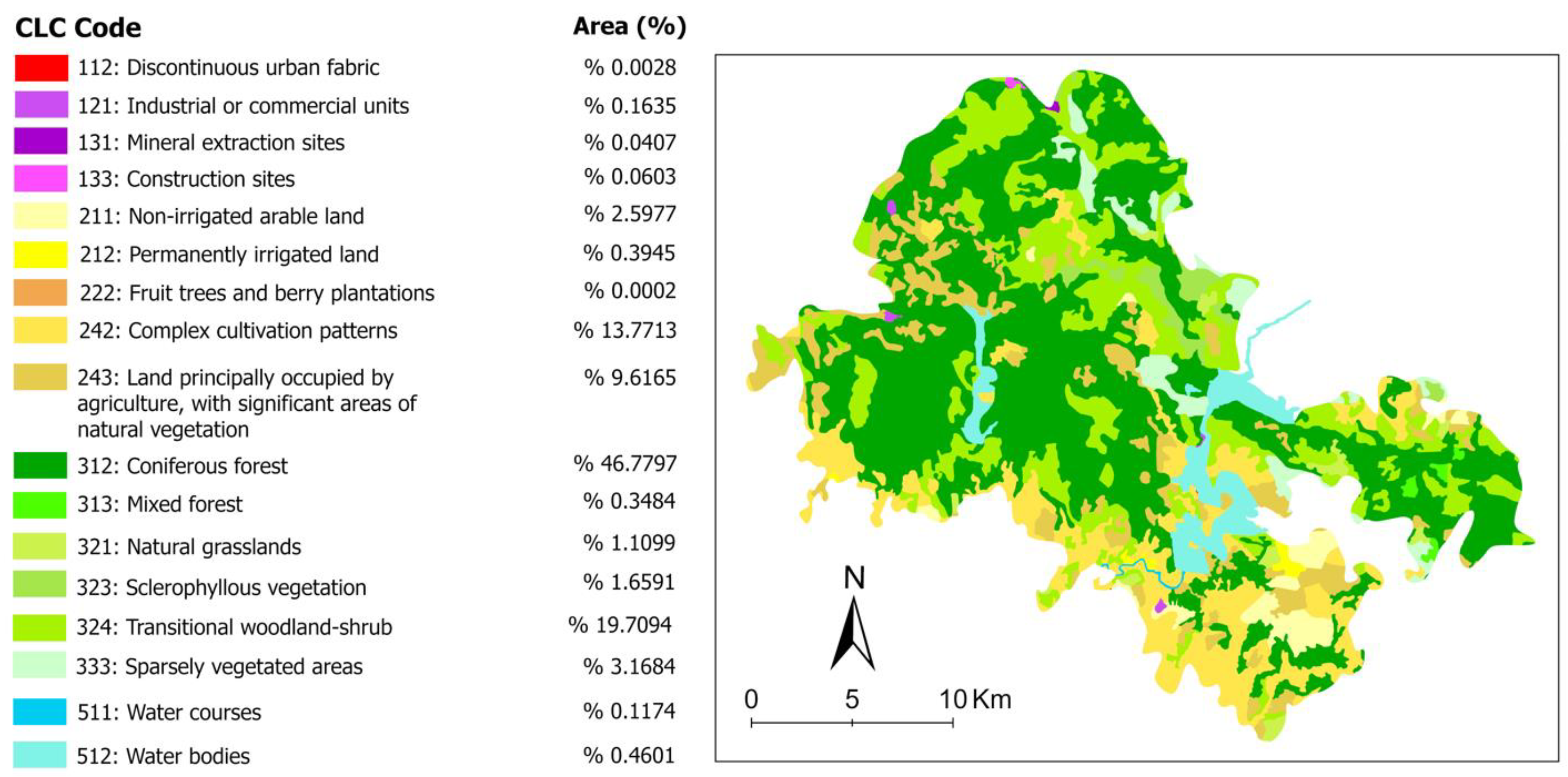Spatial Autocorrelation Analysis of CO and NO2 Related to Forest Fire Dynamics
Abstract
1. Introduction
- What are the spatial distributions of non-GHGs, specifically CO and NO2, during forest fire events in the Manavgat?
- How do variations in factors such as topography, wind speed, and fire ignition points affect the spatial distribution of CO and NO2 emissions detected by Sentinel-5P satellite data?
- What do the Univariate and Bivariate Moran’s I indices reveal about the spatial distribution of CO and NO2 during forest fire events?
2. Study Area and Data Used
- Sentinel-5P: As a satellite in the Copernicus program, it is designed to monitor atmospheric composition, including gases like nitrogen dioxide, ozone, and methane, providing crucial data on air quality and climate change. Over the fire zone, the satellite passes approximately between 10:08 and 11:28 UTC on the specified dates, subject to orbital variations.
- CO: The vertical column of CO has a spatial resolution of 1113.2 m downloaded from the Google Earth Engine (GEE) data catalog [61]. The Sentinel-5 mission consists of a high-resolution seven different spectral bands: UV-1 (270–300 nm), UV-2 (300–370 nm), VIS (370–500 nm), NIR-1 (685–710 nm), NIR-2 (755–773 nm), SWIR-1 (1590–1675 nm), and SWIR-3 (2305–2385 nm) [62]. TROPOMI on board the Sentinel 5 Precursor (Sentinel-5P) satellite observes the global abundance of CO using measurements of the Earth’s radiance in the 2.3 μm spectral region of the SWIR part of the solar spectrum [63].
- NO2: Similarly to Sentinel-5P CO, the vertical column of NO2 has the same spatial resolution (1113.2 m) and was downloaded from the GEE data catalog [61]. The TROPOMI NO2 processing system utilizes adapted algorithms from two key sources: the DOMINO-2, which is part of the Dutch OMI NO2 data products for the Ozone Monitoring Instrument (OMI), and the European Union’s QA4ECV (The European Quality Assurance for Essential Climate Variables) NO2 reprocessed dataset for OMI. These algorithms have been adapted and customized to meet the specific requirements of the TROPOMI [64].
- Digital Elevation Model (DEM): The digital elevation data used in this study was obtained from NASA’s SRTM V3 (SRTM Plus) via GEE, with a resolution of 1 arc-second (≈30 m). The dataset underwent a void-filling process using open-source data, including ASTER GDEM2, GMTED2010, and NED, ensuring complete coverage [66,67].
- VIIRS FRP values, obtained from the NASA website, were utilized in this study due to their superior spatial resolution (375 m for the Suomi NPP) compared to MODIS, enabling more precise detection of small fire hotspots [25].
3. Methodology
3.1. Preprocessing
3.2. Spatial Autocorrelation Analysis
3.2.1. Moran’s I
Univariate (UV) Moran’s I
Bivariate (BV) Moran’s I
3.2.2. Moran’s I Scatter Plots
4. Results
4.1. Temporal Analysis of CO and NO2 Values
4.2. UV Moran’s I Analysis
4.3. BV Moran’s I Analysis for CO and NO2
5. Discussion
5.1. Image Resolution and Data Quality Issues
5.2. Uncertainties Due to Topographical and Meteorological Factors
5.3. Fuel Types and Combustion Phases
6. Conclusions
- Global Spatial Autocorrelation:
- UV Global Moran’s I values for CO (0.84–0.93) and NO2 (0.90–0.94) indicated strong spatial autocorrelation;
- BV Global Moran’s I values (0.69–0.84) demonstrated significant spatial relationships between CO and NO2, reflecting interconnected dispersion patterns.
- Local Spatial Autocorrelation:
- UV Local Moran’s I analysis identified UV-HH and UV-LL clusters for CO and NO2, reflecting differences in combustion phases, chemical interactions, and atmospheric lifetimes. CO concentrations exceeded 0.10000 mol/m2, exhibited wide dispersion, while NO2 concentrations, exceeding 0.00020 mol/m2, remained localized near intense fire zones due to their shorter atmospheric lifetime;
- BV Local Moran’s I analysis revealed overlapping BV-HH (High CO, High NO2) and BV-LL (Low CO, Low NO2) clusters, shaped by topography and meteorological factors.
Author Contributions
Funding
Data Availability Statement
Conflicts of Interest
Appendix A
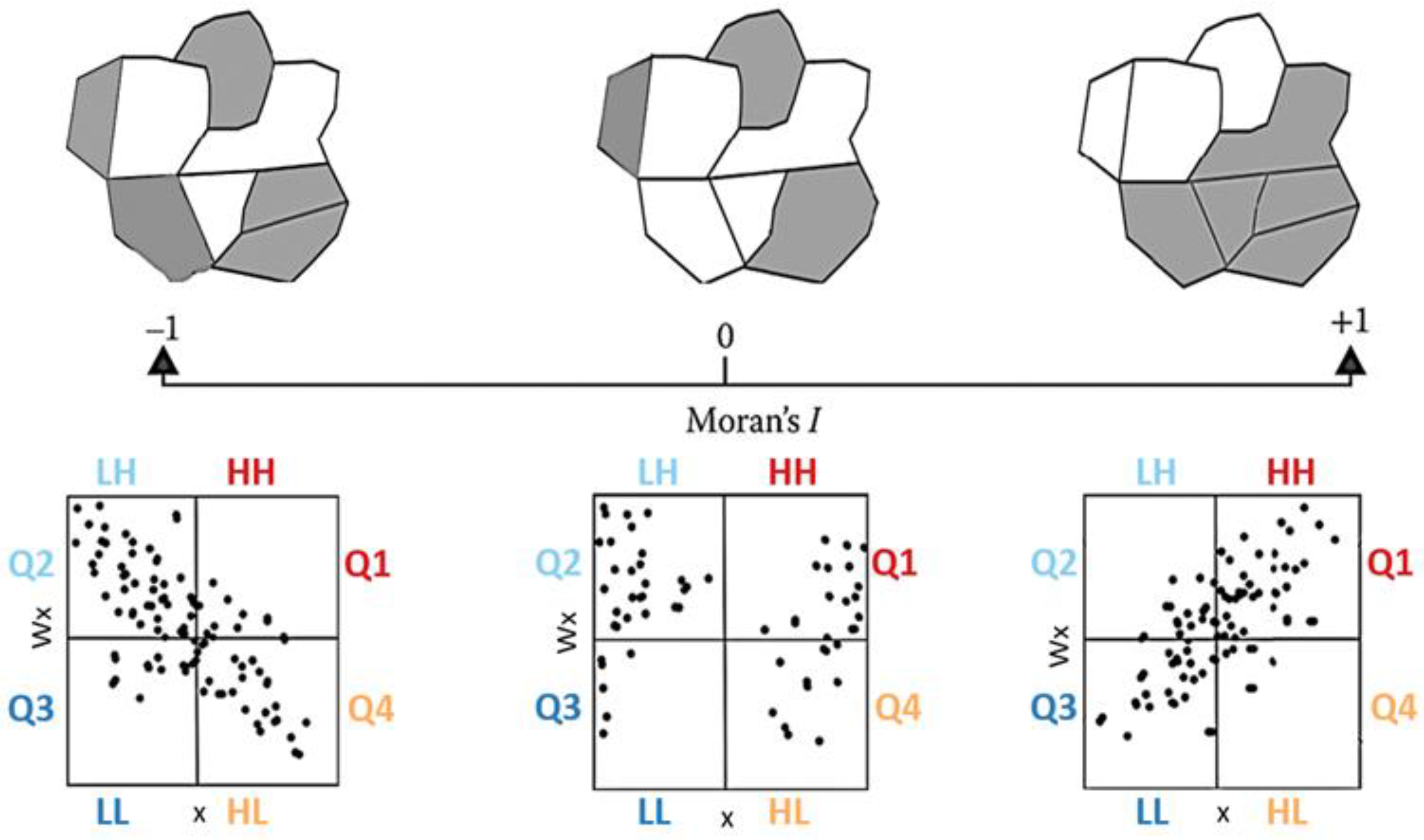
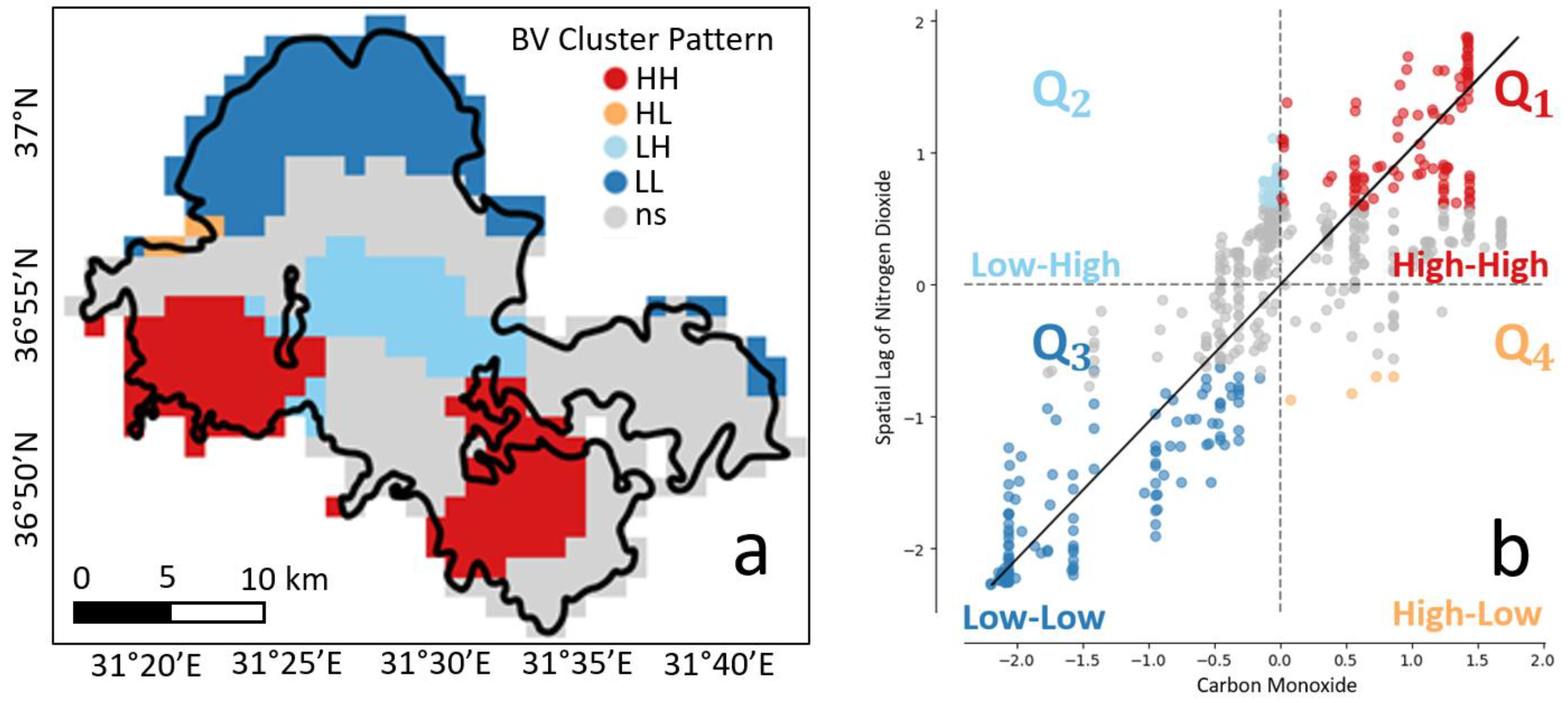
References
- Atalay, H.; Dervisoglu, A.; Sunar, A.F. Exploring Forest Fire Dynamics: Fire Danger Mapping in Antalya Region, Türkiye. ISPRS Int. J. Geo-Inf. 2024, 13, 74. [Google Scholar] [CrossRef]
- Flannigan, M.D.; Stocks, B.J.; Wotton, B.M. Climate Change and Forest Fires. Sci. Total Environ. 2000, 262, 221–229. [Google Scholar] [CrossRef] [PubMed]
- Jones, M.W.; Abatzoglou, J.T.; Veraverbeke, S.; Andela, N.; Lasslop, G.; Forkel, M.; Smith, A.J.P.; Burton, C.; Betts, R.A.; Van Der Werf, G.R.; et al. Global and Regional Trends and Drivers of Fire Under Climate Change. Rev. Geophys. 2022, 60, e2020RG000726. [Google Scholar] [CrossRef]
- Geraskina, A.P.; Tebenkova, D.N.; Ershov, D.V.; Ruchinskaya, E.V.; Sibirtseva, N.V.; Lukina, N.V. Wildfires as a Factor of Loss of Biodiversity and Forest Ecosystem Functions. For. Sci. 2022, 5, 97. [Google Scholar] [CrossRef]
- Mastachi-Loza, C.A.; Paredes-Tavares, J.; Becerril-Piña, R.; Ruiz-Gómez, M.d.L.; Rangel Patiño, C.A.; Diaz-Delgado, C. The House Is Burning: Assessment of Habitat Loss Due to Wildfires in Central Mexico. Fire 2024, 7, 134. [Google Scholar] [CrossRef]
- He, T.; Lamont, B.B.; Pausas, J.G. Fire as a Key Driver of Earth’s Biodiversity. Biol. Rev. 2019, 94, 1983–2010. [Google Scholar] [CrossRef]
- Kharuk, V.I.; Ponomarev, E.I.; Ivanova, G.A.; Dvinskaya, M.L.; Coogan, S.C.P.; Flannigan, M.D. Wildfires in the Siberian Taiga. Ambio 2021, 50, 1953–1974. [Google Scholar] [CrossRef]
- Pausas, J.G.; Keeley, J.E. Wildfires as an Ecosystem Service. Front. Ecol. Environ. 2019, 17, 289–295. [Google Scholar] [CrossRef]
- Bilgiç, E.; Tuygun, G.T.; Gündüz, O. Development of an Emission Estimation Method with Satellite Observations for Significant Forest Fires and Comparison with Global Fire Emission Inventories: Application to Catastrophic Fires of Summer 2021 over the Eastern Mediterranean. Atmos. Environ. 2023, 308, 119871. [Google Scholar] [CrossRef]
- Rasul, A.; Ibrahim, G.R.F.; Hameed, H.M.; Tansey, K. A Trend of Increasing Burned Areas in Iraq from 2001 to 2019. Environ. Dev. Sustain. 2021, 23, 5739–5755. [Google Scholar] [CrossRef]
- Karam, N.Z.; Ahmed, B.A. Assessment of the Forest Fire Damage Using Remote Sensing in Mosul City, Iraq; AIP Publishing: Melville, NY, USA, 2024; Volume 3249. [Google Scholar]
- Mahmood, M.R.; Jumaah, H.J. NBR Index-Based Fire Detection Using Sentinel-2 Images and GIS: A Case Study in Mosul Park, Iraq. Int. J. Geoinformatics 2023, 19, 67–74. [Google Scholar]
- Farid, A.; Alam, M.K.; Goli, V.S.N.S.; Akin, I.D.; Akinleye, T.; Chen, X.; Cheng, Q.; Cleall, P.; Cuomo, S.; Foresta, V. A Review of the Occurrence and Causes for Wildfires and Their Impacts on the Geoenvironment. Fire 2024, 7, 295. [Google Scholar] [CrossRef]
- Canadell, J.G.; Poulter, B.; Bastos, A.; Ciais, P.; Hayes, D.J.; Thompson, R.L.; Villalobos, Y. Balancing Greenhouse Gas Sources and Sinks: Inventories, Budgets, and Climate Policy. In Balancing Greenhouse Gas Budgets; Elsevier: Amsterdam, The Netherlands, 2022; pp. 3–28. [Google Scholar]
- Joshi, A.; Pathak, M.; Kuttippurath, J.; Patel, V.K. Adoption of Cleaner Technologies and Reduction in Fire Events in the Hotspots Lead to Global Decline in Carbon Monoxide. Chemosphere 2023, 336, 139259. [Google Scholar] [CrossRef] [PubMed]
- Mebust, A.K.; Cohen, R.C. Space-Based Observations of Fire NOx Emission Coefficients: A Global Biome-Scale Comparison. Atmos. Chem. Phys. 2014, 14, 2509–2524. [Google Scholar] [CrossRef]
- Schreier, S.F.; Richter, A.; Kaiser, J.W.; Burrows, J.P. The Empirical Relationship between Satellite-Derived Tropospheric NO2 and Fire Radiative Power and Possible Implications for Fire Emission Rates of NOx. Atmos. Chem. Phys. 2014, 14, 2447–2466. [Google Scholar] [CrossRef]
- Tanimoto, H.; Ikeda, K.; Boersma, K.F.; Garivait, S. Interannual Variability of Nitrogen Oxides Emissions from Boreal Fires in Siberia and Alaska during 1996–2011 as Observed from Space. Environ. Res. Lett. 2015, 10, 065004. [Google Scholar] [CrossRef]
- Yu, B.; Chen, F.; Shirazi, Z. Impact of Biomass Fires on Tropospheric Nitrogen Dioxide in South and Southeast Asia for the Years from 2005 to 2014. Appl. Geogr. 2017, 86, 92–101. [Google Scholar] [CrossRef]
- Volkova, L.; Roxburgh, S.H.; Weston, C.J. Effects of Prescribed Fire Frequency on Wildfire Emissions and Carbon Sequestration in a Fire Adapted Ecosystem Using a Comprehensive Carbon Model. J. Environ. Manag. 2021, 290, 112673. [Google Scholar] [CrossRef]
- Martin, R.V. Satellite Remote Sensing of Surface Air Quality. Atmos. Environ. 2008, 42, 7823–7843. [Google Scholar] [CrossRef]
- Zhou, B.; Zhang, S.; Xue, R.; Li, J.; Wang, S. A Review of Space-Air-Ground Integrated Remote Sensing Techniques for Atmospheric Monitoring. J. Environ. Sci. 2023, 123, 3–14. [Google Scholar] [CrossRef]
- Vîrghileanu, M.; Săvulescu, I.; Mihai, B.-A.; Nistor, C.; Dobre, R. Nitrogen Dioxide (NO2) Pollution Monitoring with Sentinel-5P Satellite Imagery over Europe during the Coronavirus Pandemic Outbreak. Remote Sens. 2020, 12, 3575. [Google Scholar] [CrossRef]
- Magro, C.; Nunes, L.; Gonçalves, O.C.; Neng, N.R.; Nogueira, J.M.; Rego, F.C.; Vieira, P. Atmospheric Trends of CO and CH4 from Extreme Wildfires in Portugal Using Sentinel-5P TROPOMI Level-2 Data. Fire 2021, 4, 25. [Google Scholar] [CrossRef]
- NASA-FIRMS Archive. Available online: https://firms.modaps.eosdis.nasa.gov/map/ (accessed on 22 April 2024).
- Liu, T.; Mickley, L.J.; Marlier, M.E.; DeFries, R.S.; Khan, M.F.; Latif, M.T.; Karambelas, A. Diagnosing Spatial Biases and Uncertainties in Global Fire Emissions Inventories: Indonesia as Regional Case Study. Remote Sens. Environ. 2020, 237, 111557. [Google Scholar] [CrossRef]
- Van Der Velde, I.R.; Van Der Werf, G.R.; Houweling, S.; Eskes, H.J.; Veefkind, J.P.; Borsdorff, T.; Aben, I. Biomass Burning Combustion Efficiency Observed from Space Using Measurements of CO and NO2 by the TROPOspheric Monitoring Instrument (TROPOMI). Atmos. Chem. Phys. 2021, 21, 597–616. [Google Scholar] [CrossRef]
- Bar, S.; Parida, B.R.; Pandey, A.C.; Kumar, N. Pixel-Based Long-Term (2001–2020) Estimations of Forest Fire Emissions over the Himalaya. Remote Sens. 2022, 14, 5302. [Google Scholar] [CrossRef]
- Cruz-López, M.I.; Manzo-Delgado, L.d.L.; Aguirre-Gómez, R.; Chuvieco, E.; Equihua-Benítez, J.A. Spatial Distribution of Forest Fire Emissions: A Case Study in Three Mexican Ecoregions. Remote Sens. 2019, 11, 1185. [Google Scholar] [CrossRef]
- Yilmaz, O.S.; Acar, U.; Sanli, F.B.; Gulgen, F.; Ates, A.M. Mapping Burn Severity and Monitoring CO Content in Türkiye’s 2021 Wildfires, Using Sentinel-2 and Sentinel-5P Satellite Data on the GEE Platform. Earth Sci. Inf. 2023, 16, 221–240. [Google Scholar] [CrossRef]
- Eke, M.; Cingiroglu, F.; Kaynak, B. Investigation of 2021 Wildfire Impacts on Air Quality in Southwestern Turkey. Atmos. Environ. 2024, 325, 120445. [Google Scholar] [CrossRef]
- Serifoglu Yilmaz, C. Assessing Air Pollutant Emissions in the Aftermath of the 2021 Forest Fires in Marmaris and Manavgat, TÜRKİYE: Insights from Satellite-Based Monitoring. Int. Arch. Photogramm. Remote Sens. Spat. Inf. Sci. 2024, 48, 329–336. [Google Scholar] [CrossRef]
- Anselin, L. Local Indicators of Spatial Association-LISA. Geogr. Anal. 1995, 27, 93–115. [Google Scholar] [CrossRef]
- Anselin, L.; Sridharan, S.; Gholston, S. Using Exploratory Spatial Data Analysis to Leverage Social Indicator Databases: The Discovery of Interesting Patterns. Soc. Indic. Res. Int. Interdiscip. J. Qual.-Life Meas. 2007, 82, 287–309. [Google Scholar] [CrossRef]
- Anselin, L.; Syabri, I.; Kho, Y. GeoDa: An Introduction to Spatial Data Analysis. In Handbook of Applied Spatial Analysis; Fischer, M.M., Getis, A., Eds.; Springer: Berlin/Heidelberg, Germany, 2010; pp. 73–89. ISBN 978-3-642-03646-0. [Google Scholar]
- Roy, S.; Bose, A.; Majumder, S.; Roy Chowdhury, I.; Abdo, H.G.; Almohamad, H.; Abdullah Al Dughairi, A. Evaluating Urban Environment Quality (UEQ) for Class-I Indian City: An Integrated RS-GIS Based Exploratory Spatial Analysis. Geocarto Int. 2023, 38, 2153932. [Google Scholar] [CrossRef]
- Getis, A.; Ord, J.K. The Analysis of Spatial Association by Use of Distance Statistics. Geogr. Anal. 1992, 24, 189–206. [Google Scholar] [CrossRef]
- Geary, R.C. The Contiguity Ratio and Statistical Mapping. Inc. Stat. 1954, 5, 115. [Google Scholar] [CrossRef]
- Tango, T. A Class of Tests for Detecting ‘General’ and ‘Focused’ Clustering of Rare Diseases. Stat. Med. 1995, 14, 2323–2334. [Google Scholar] [CrossRef]
- Fu, W.J.; Jiang, P.K.; Zhou, G.M.; Zhao, K.L. Using Moran’s I and GIS to Study the Spatial Pattern of Forest Litter Carbon Density in a Subtropical Region of Southeastern China. Biogeosciences 2014, 11, 2401–2409. [Google Scholar] [CrossRef]
- Kganyago, M.; Shikwambana, L. Assessment of the Characteristics of Recent Major Wildfires in the USA, Australia and Brazil in 2018–2019 Using Multi-Source Satellite Products. Remote Sens. 2020, 12, 1803. [Google Scholar] [CrossRef]
- Moura, A.C.M.; Fonseca, B.M. ESDA (Exploratory Spatial Data Analysis) of Vegetation Cover in Urban Areas—Recognition of Vulnerabilities for the Management of Resources in Urban Green Infrastructure. Sustainability 2020, 12, 1933. [Google Scholar] [CrossRef]
- Squeri, C.; Poni, S.; Di Gennaro, S.F.; Matese, A.; Gatti, M. Comparison and Ground Truthing of Different Remote and Proximal Sensing Platforms to Characterize Variability in a Hedgerow-Trained Vineyard. Remote Sens. 2021, 13, 2056. [Google Scholar] [CrossRef]
- Ding, X.; Shu, Y.; Tang, X.; Ma, J. Identifying Driving Factors of Basin Ecosystem Service Value Based on Local Bivariate Spatial Correlation Patterns. Land 2022, 11, 1852. [Google Scholar] [CrossRef]
- Adamiak, C.; Szyda, B.; Dubownik, A.; García-Álvarez, D. Airbnb Offer in Spain—Spatial Analysis of the Pattern and Determinants of Its Distribution. ISPRS Int. J. Geo-Inf. 2019, 8, 155. [Google Scholar] [CrossRef]
- Wang, Z.; Liu, Y.; Zhang, Y.; Liu, Y.; Wang, B.; Zhang, G. Spatially Varying Relationships between Land Subsidence and Urbanization: A Case Study in Wuhan, China. Remote Sens. 2022, 14, 291. [Google Scholar] [CrossRef]
- Gianquintieri, L.; Mahakalkar, A.U.; Caiani, E.G. Exploring Spatial–Temporal Patterns of Air Pollution Concentration and Their Relationship with Land Use. Atmosphere 2024, 15, 699. [Google Scholar] [CrossRef]
- Habibi, R.; Alesheikh, A.A.; Mohammadinia, A.; Sharif, M. An Assessment of Spatial Pattern Characterization of Air Pollution: A Case Study of CO and PM 2.5 in Tehran, Iran. ISPRS Int. J. Geo-Inf. 2017, 6, 270. [Google Scholar] [CrossRef]
- Oom, D.; Pereira, J.M. Exploratory Spatial Data Analysis of Global MODIS Active Fire Data. Int. J. Appl. Earth Obs. Geoinf. 2013, 21, 326–340. [Google Scholar] [CrossRef]
- Wang, B.; Li, W.; Lai, G.; Chang, N.; Chen, F.; Bai, Y.; Liu, X. Forest Fire Spread Hazard and Landscape Pattern Characteristics in the Mountainous District, Beijing. Forests 2023, 14, 2139. [Google Scholar] [CrossRef]
- Shao, Y.; Wang, Z.; Feng, Z.; Sun, L.; Yang, X.; Zheng, J.; Ma, T. Assessment of China’s Forest Fire Occurrence with Deep Learning, Geographic Information and Multisource Data. J. For. Res. 2023, 34, 963–976. [Google Scholar] [CrossRef]
- Yang, J.; Guo, K.; Dai, Y.; Tian, S.; Wang, W.; Jiang, Z.; Dai, Z. Spatial Layout Siting Method for Fire Stations Based on Comprehensive Forest Fire Risk Distribution. Case Stud. Therm. Eng. 2023, 49, 103243. [Google Scholar] [CrossRef]
- Zhang, X.; Liao, Q.; Zhao, H.; Li, P. Vector Maps and Spatial Autocorrelation of Carbon Emissions at Land Patch Level Based on Multi-Source Data. Front. Public Health 2022, 10, 1006337. [Google Scholar] [CrossRef]
- Atalay, H.; Dervisoglu, A.; Sunar, F. Fire Weather Index and Forest Fire Danger Mapping: Insights from a Case Study in Antalya-Manavgat Forest, Türkiye. Int. Arch. Photogramm. Remote Sens. Spat. Inf. Sci. 2024, 48, 53–59. [Google Scholar] [CrossRef]
- OGM. Available online: https://www.ogm.gov.tr/tr/e-kutuphane-sitesi/YanginYonetimPlanlari/AntalyaOBM-Manavgat%20Yang%C4%B1n%20Y%C3%B6netim%20Plan%C4%B1.pdf (accessed on 3 July 2024).
- Global Forest Watch Forest Monitoring, Land Use & Deforestation Trends|Global Forest Watch. Available online: https://www.globalforestwatch.org/ (accessed on 29 April 2024).
- Çolak, E.; Sunar, F. Evaluation of Forest Fire Risk in the Mediterranean Turkish Forests: A Case Study of Menderes Region, Izmir. Int. J. Disaster Risk Reduct. 2020, 45, 101479. [Google Scholar] [CrossRef]
- Çolak, E.; Sunar, F. The Importance of Ground-Truth and Crowdsourcing Data for the Statistical and Spatial Analyses of the NASA FIRMS Active Fires in the Mediterranean Turkish Forests. Remote Sens. Appl. Soc. Environ. 2020, 19, 100327. [Google Scholar] [CrossRef]
- CORINE Land Cover 2018 (Vector/Raster 100 m), Europe, 6-Yearly. Available online: https://land.copernicus.eu/en/products/corine-land-cover/clc2018 (accessed on 29 November 2024).
- Copernicus CORINE Land Cover|Earth Engine Data Catalog. Available online: https://developers.google.com/earth-engine/datasets/catalog/COPERNICUS_CORINE_V20_100m (accessed on 29 November 2024).
- Earth Engine Data Catalog|Google for Developers. Available online: https://developers.google.com/earth-engine/datasets/catalog/ (accessed on 22 April 2024).
- Sentinel. Available online: https://custom-scripts.sentinel-hub.com/custom-scripts/sentinel/sentinel-5p/ (accessed on 16 April 2024).
- Sentinel-5P NRTI CO: Near Real-Time Carbon Monoxide|Earth Engine Data Catalog. Available online: https://developers.google.com/earth-engine/datasets/catalog/COPERNICUS_S5P_NRTI_L3_CO (accessed on 22 April 2024).
- Sentinel-5P NRTI NO2: Near Real-Time Nitrogen Dioxide|Earth Engine Data Catalog. Available online: https://developers.google.com/earth-engine/datasets/catalog/COPERNICUS_S5P_NRTI_L3_NO2 (accessed on 22 April 2024).
- Lambert, J.-C.; Compernolle, S.; Eichmann, K.-U.; de Graaf, M.; Hubert, D.; Keppens, A.; Kleipool, Q.; Langerock, B.; Sha, M.K.; Verhoelst, T.; et al. S5P Mission Performance Centre. In Quarterly Validation Report of the Copernicus Sentinel-5 Precursor Operational Data Products #10: April 2018–March 2021; Sentinel-5 Precursor Mission Performance Centre: Kiruna, Sweden, 2021; p. 170. Available online: https://mpc-vdaf.tropomi.eu/ProjectDir/reports/pdf/S5P-MPC-IASB-ROCVR-10.01.00-20210326-signed.pdf (accessed on 4 February 2025).
- Farr, T.G.; Rosen, P.A.; Caro, E.; Crippen, R.; Duren, R.; Hensley, S.; Kobrick, M.; Paller, M.; Rodriguez, E.; Roth, L.; et al. The Shuttle Radar Topography Mission. Rev. Geophys. 2007, 45, 2005RG000183. [Google Scholar] [CrossRef]
- NASA SRTM Digital Elevation 30m|Earth Engine Data Catalog. Available online: https://developers.google.com/earth-engine/datasets/catalog/USGS_SRTMGL1_003 (accessed on 28 April 2024).
- Moran, P.A. The Interpretation of Statistical Maps. J. R. Stat. Society. Ser. B (Methodol.) 1948, 10, 243–251. [Google Scholar] [CrossRef]
- Kumari, M.; Sarma, K.; Sharma, R. Using Moran’s I and GIS to Study the Spatial Pattern of Land Surface Temperature in Relation to Land Use/Cover around a Thermal Power Plant in Singrauli District, Madhya Pradesh, India. Remote Sens. Appl. Soc. Environ. 2019, 15, 100239. [Google Scholar] [CrossRef]
- Yang, Y.; Li, J.; Zhu, G.; Yuan, Q. Spatio–Temporal Relationship and Evolvement of Socioeconomic Factors and PM 2.5 in China during 1998–2016. Int. J. Environ. Res. Public Health 2019, 16, 1149. [Google Scholar] [CrossRef]
- Cheng, Z.; Xu, S.; Na, X.; Zhang, X.; Ma, D.; Zhang, P. Spatial-Heterogeneity Analysis of the Heavy Metals Cd and Pb in Road Dust in the Main Urban Area of Harbin. Sustainability 2022, 14, 8007. [Google Scholar] [CrossRef]
- Gedamu, W.T.; Plank-Wiedenbeck, U.; Wodajo, B.T. A Spatial Autocorrelation Analysis of Road Traffic Crash by Severity Using Moran’s I Spatial Statistics: A Comparative Study of Addis Ababa and Berlin Cities. Accid. Anal. Prev. 2024, 200, 107535. [Google Scholar] [CrossRef]
- Matese, A.; Di Gennaro, S.F.; Santesteban, L.G. Methods to Compare the Spatial Variability of UAV-Based Spectral and Geometric Information with Ground Autocorrelated Data. A Case of Study for Precision Viticulture. Comput. Electron. Agric. 2019, 162, 931–940. [Google Scholar] [CrossRef]
- Radmehr, R.; Henneberry, S.R.; Shayanmehr, S. Renewable Energy Consumption, CO2 Emissions, and Economic Growth Nexus: A Simultaneity Spatial Modeling Analysis of EU Countries. Struct. Change Econ. Dyn. 2021, 57, 13–27. [Google Scholar] [CrossRef]
- Aldstadt, J. Spatial Clustering. In Handbook of Applied Spatial Analysis; Fischer, M.M., Getis, A., Eds.; Springer: Berlin/Heidelberg, Germany, 2010; pp. 279–300. ISBN 978-3-642-03646-0. [Google Scholar]
- Yue, H.; Duan, L.; Lu, M.; Huang, H.; Zhang, X.; Liu, H. Modeling the Determinants of PM2.5 in China Considering the Localized Spatiotemporal Effects: A Multiscale Geographically Weighted Regression Method. Atmosphere 2022, 13, 627. [Google Scholar] [CrossRef]
- Saputra, W.; Giyarsih, S.R.; Muhidin, S. Spatial Analysis of Slum Areas on the Riverbanks of Palembang City Using the Anselin Local Moran’s I Analysis. GeoJournal 2023, 88, 6523–6538. [Google Scholar] [CrossRef]
- Zhang, B.; Jiang, Z.; Chen, Y.; Cheng, N.; Khan, U.; Deng, J. Geochemical Association Rules of Elements Mined Using Clustered Events of Spatial Autocorrelation: A Case Study in the Chahanwusu River Area, Qinghai Province, China. Appl. Sci. 2022, 12, 2247. [Google Scholar] [CrossRef]
- Zhao, X.; Griffin, D.; Fioletov, V.; McLinden, C.; Cede, A.; Tiefengraber, M.; Müller, M.; Bognar, K.; Strong, K.; Boersma, F. Assessment of the Quality of TROPOMI High-Spatial-Resolution NO2 Data Products in the Greater Toronto Area. Atmos. Meas. Tech. 2020, 13, 2131–2159. [Google Scholar] [CrossRef]
- Wan, N.; Xiong, X.; Kluitenberg, G.J.; Hutchinson, J.S.; Aiken, R.; Zhao, H.; Lin, X. Estimation of Biomass Burning Emission of NO2 and CO from 2019–2020 Australia Fires Based on Satellite Observations. Atmos. Chem. Phys. 2023, 23, 711–724. [Google Scholar] [CrossRef]
- Timmermans, R.; Segers, A.; Curier, L.; Abida, R.; Attié, J.-L.; El Amraoui, L.; Eskes, H.; De Haan, J.; Kujanpää, J.; Lahoz, W. Impact of Synthetic Space-Borne NO 2 Observations from the Sentinel-4 and Sentinel-5P Missions on Tropospheric NO2 Analyses. Atmos. Chem. Phys. 2019, 19, 12811–12833. [Google Scholar] [CrossRef]
- Reshi, A.R.; Pichuka, S.; Tripathi, A. Applications of Sentinel-5P TROPOMI Satellite Sensor: A Review. IEEE Sens. J. 2024, 24, 20312–20321. [Google Scholar] [CrossRef]
- Hoinaski, L.; Will, R.; Ribeiro, C.B. Brazilian Atmospheric Inventories–BRAIN: A Comprehensive Database of Air Quality in Brazil. Earth Syst. Sci. Data 2024, 16, 2385–2405. [Google Scholar] [CrossRef]
- Morillas, C.; Alvarez, S.; Serio, C.; Masiello, G.; Martinez, S. TROPOMI NO2 Sentinel-5P Data in the Community of Madrid: A Detailed Consistency Analysis with in Situ Surface Observations. Remote Sens. Appl. Soc. Environ. 2024, 33, 101083. [Google Scholar] [CrossRef]
- U.S. National Interagency Fire Center; National Wildfire Coordinating Group; Fire Use Working Team. Fire Effects Guide; National Wildlife Coordinating Group: Boise, ID, USA, 1994. Available online: https://www.npshistory.com/publications/fire/feg.pdf (accessed on 4 February 2025).
- Spittlehouse, D.L.; Dymond, C.C. Interaction of Elevation and Climate Change on Fire Weather Risk. Can. J. For. Res. 2022, 52, 237–249. [Google Scholar] [CrossRef]
- Zahran, E.; Shams, S.; Said, S.; Zahran, E.; Gadong, B.; Brunei-Muara, B.D. Validation of Forest Fire Hotspot Analysis in GIS Using Forest Fire Contributory Factors. Syst. Rev. Pharm 2020, 11, 249–255. [Google Scholar]
- Giovannini, L.; Ferrero, E.; Karl, T.; Rotach, M.W.; Staquet, C.; Trini Castelli, S.; Zardi, D. Atmospheric Pollutant Dispersion over Complex Terrain: Challenges and Needs for Improving Air Quality Measurements and Modeling. Atmosphere 2020, 11, 646. [Google Scholar] [CrossRef]
- Reisen, F.; Meyer, C.M.; McCaw, L.; Powell, J.C.; Tolhurst, K.; Keywood, M.D.; Gras, J.L. Impact of Smoke from Biomass Burning on Air Quality in Rural Communities in Southern Australia. Atmos. Environ. 2011, 45, 3944–3953. [Google Scholar] [CrossRef]
- Reisen, F.; Duran, S.M.; Flannigan, M.; Elliott, C.; Rideout, K. Wildfire Smoke and Public Health Risk. Int. J. Wildland Fire 2015, 24, 1029–1044. [Google Scholar] [CrossRef]
- Wen, Y.; Xiao, J.; Yang, J.; Cai, S.; Liang, M.; Zhou, P. Quantitatively Disentangling the Geographical Impacts of Topography on PM 2.5 Pollution in China. Remote Sens. 2022, 14, 6309. [Google Scholar] [CrossRef]
- Clements, C.B. Effects of Complex Terrain on Extreme Fire Behavior. In Synthesis of Knowledge of Extreme Fire Behavior: Volume I for Fire Managers; USDA: Washington, DC, USA, 2011; p. 5. [Google Scholar]
- Kant Sharma, L.; Kanga, S.; Singh Nathawat, M.; Sinha, S.; Chandra Pandey, P. Fuzzy AHP for Forest Fire Risk Modeling. Disaster Prev. Manag. Int. J. 2012, 21, 160–171. [Google Scholar] [CrossRef]
- Werth, P.; Potter, B.; Clements, C.; Finney, M.; Goodrick, S.; Alexander, M.; Cruz, M.; Forthofer, J.; McAllister, S. Synthesis of Knowledge of Extreme Fire Behavior: Volume I for Fire Managers; USDA: Washington, DC, USA, 2011.
- Liu, Y.; Heilman, W.E.; Potter, B.E.; Clements, C.B.; Jackson, W.A.; French, N.H.; Goodrick, S.L.; Kochanski, A.K.; Larkin, N.K.; Lahm, P.W. Smoke Plume Dynamics. In Wildland Fire Smoke United States; Springer: Cham, Switzerland, 2022; p. 83. [Google Scholar]
- Garcia-Menendez, F.; Hu, Y.; Odman, M.T. Simulating Smoke Transport from Wildland Fires with a Regional-scale Air Quality Model: Sensitivity to Uncertain Wind Fields. JGR Atmos. 2013, 118, 6493–6504. [Google Scholar] [CrossRef]
- Lotrecchiano, N.; Sofia, D.; Giuliano, A.; Barletta, D.; Poletto, M. Pollution Dispersion from a Fire Using a Gaussian Plume Model. Int. J. Saf. Secur. Eng 2020, 10, 431–439. [Google Scholar] [CrossRef]
- Miranda, A.I.; Borrego, C.; Vicgas, D. Forest Fire Effects on the Air Quality. In WIT Transactions on Ecology and the Environment, Air Pollution II: Computer Simulation (Volume 1); WIT Press: Southampton, UK, 1994; Available online: https://www.witpress.com/elibrary/wit-transactions-on-ecology-and-the-environment/3/11014 (accessed on 4 February 2025).
- Liu, P.; Zhang, G. A Case Study on the Integration of Remote Sensing for Predicting Complicated Forest Fire Spread. Remote Sens. 2024, 16, 3969. [Google Scholar] [CrossRef]
- Çamalan, G.; Sercan, A.; Pekin, M.A. Using Meteorological Early Warning System (MEUS) and Meteorological Indices for Assessment of Manavgat Forest Fires Occurred in Turkiye July–August 2021. Eur. J. For. Eng. 2023, 9, 10–25. [Google Scholar] [CrossRef]
- Silva, W.L.; Neto, F.A.; França, G.B.; Matschinske, M.R. Conceptual Model for Runway Change Procedure in Guarulhos International Airport Based on SODAR Data. Aeronaut. J. 2016, 120, 725–734. [Google Scholar] [CrossRef][Green Version]
- Foszcz, D.; Niedoba, T.; Siewior, J. Models of Air Pollution Propagation in the Selected Region of Katowice. Atmosphere 2021, 12, 695. [Google Scholar] [CrossRef]
- Goodrick, S.L.; Achtemeier, G.L.; Larkin, N.K.; Liu, Y.; Strand, T.M. Modelling Smoke Transport from Wildland Fires: A Review. Int. J. Wildland Fire 2012, 22, 83–94. [Google Scholar] [CrossRef]
- Markiewicz, M. Methods of Determining Meteorological Data Used in Air Pollution Dispersion Models. Environ. Prot. Eng. 2007, 33, 75–86. [Google Scholar]
- Lee, B.; Cho, S.; Lee, S.-K.; Woo, C.; Park, J. Development of a Smoke Dispersion Forecast System for Korean Forest Fires. Forests 2019, 10, 219. [Google Scholar] [CrossRef]
- WWF-Türkiye Akdeniz Bölgesi’ndeki Büyük Orman Yanginlarinin Ekolojik Ve Sosyo-Ekonomik Etkileri [Ecological and Socio-Economic Impacts of Large Forest Fires in the Mediterranean Region]. Available online: https://wwftr.awsassets.panda.org/downloads/ormanyangnlarformakucuk.pdf (accessed on 14 November 2024).
- Akkaş, M.E.; Bucak, C.; Boza, Z.; Eronat, H.; Bekereci, A.; Erkan, A.; Cebeci, C. Büyük Orman Yangınlarının Meteorolojik Verilerin Işığında İncelenmesi [The Investigation of the Great Wild Fires Based on Meteorological Data]. TC Ministry of Environment and Forestry, General Directorate of Forestry, Ege Forestry Research Institute, Technical Bulletin No. 36, ISSN 1300-9508, İzmir, Türkiye. 2008. Available online: https://www.yumpu.com/tr/document/read/4167281/yayn-indir-ege-ormanclk-arastrma-enstitusu (accessed on 4 February 2025).
- Guo, L.; Ma, Y.; Tigabu, M.; Guo, X.; Zheng, W.; Guo, F. Emission of Atmospheric Pollutants during Forest Fire in Boreal Region of China. Environ. Pollut. 2020, 264, 114709. [Google Scholar] [CrossRef]
- Pallozzi, E.; Lusini, I.; Cherubini, L.; Hajiaghayeva, R.A.; Ciccioli, P.; Calfapietra, C. Differences between a Deciduous and a Conifer Tree Species in Gaseous and Particulate Emissions from Biomass Burning. Environ. Pollut. 2018, 234, 457–467. [Google Scholar] [CrossRef]
- Atalay, H.; Sunar, A.F.; Dervisoglu, A. Investigating FWI Moisture Codes in Relation to Satellite-Derived Soil Moisture Data across Varied Resolutions. Fire 2024, 7, 272. [Google Scholar] [CrossRef]
- Akagi, S.K.; Yokelson, R.J.; Wiedinmyer, C.; Alvarado, M.J.; Reid, J.S.; Karl, T.; Crounse, J.D.; Wennberg, P.O. Emission Factors for Open and Domestic Biomass Burning for Use in Atmospheric Models. Atmos. Chem. Phys. 2011, 11, 4039–4072. [Google Scholar] [CrossRef]
- Andreae, M.O.; Merlet, P. Emission of Trace Gases and Aerosols from Biomass Burning. Glob. Biogeochem. Cycles 2001, 15, 955–966. [Google Scholar] [CrossRef]
- Times, G. Forest Fire Rages in Turkey’s Resort City Antalya–Global Times. Available online: https://www.globaltimes.cn/page/202108/1230273.shtml (accessed on 21 January 2025).
- Santoso, M.A.; Christensen, E.G.; Yang, J.; Rein, G. Review of the Transition from Smouldering to Flaming Combustion in Wildfires. Front. Mech. Eng. 2019, 5, 49. [Google Scholar] [CrossRef]
- Van Leeuwen, T.T.; Van Der Werf, G.R. Spatial and Temporal Variability in the Ratio of Trace Gases Emitted from Biomass Burning. Atmos. Chem. Phys. 2011, 11, 3611–3629. [Google Scholar] [CrossRef]
- Oyana, T.J. Spatial Analysis with r: Statistics, Visualization, and Computational Methods; CRC Press: Boca Raton, FL, USA, 2020; ISBN 978-1-00-302164-3. [Google Scholar]
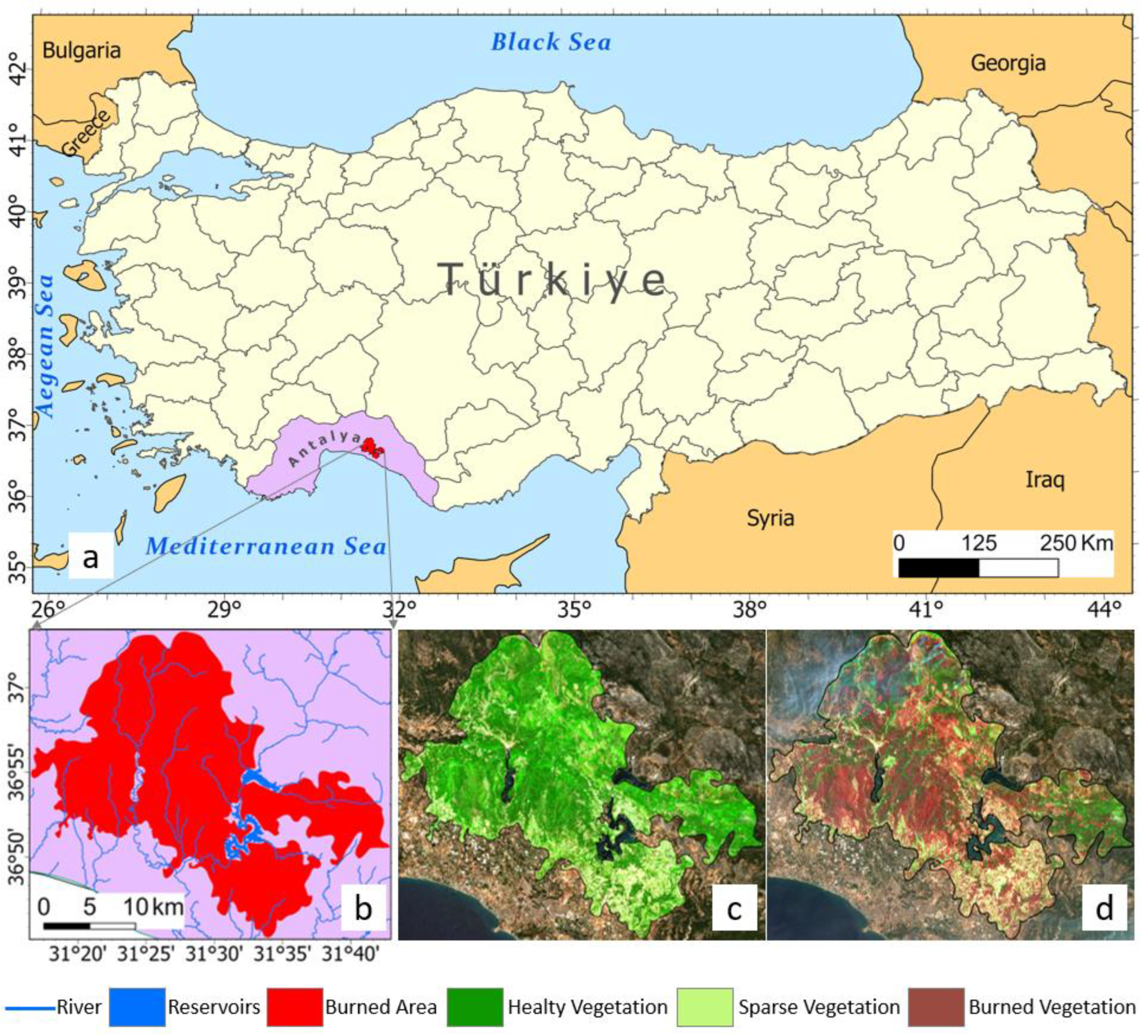
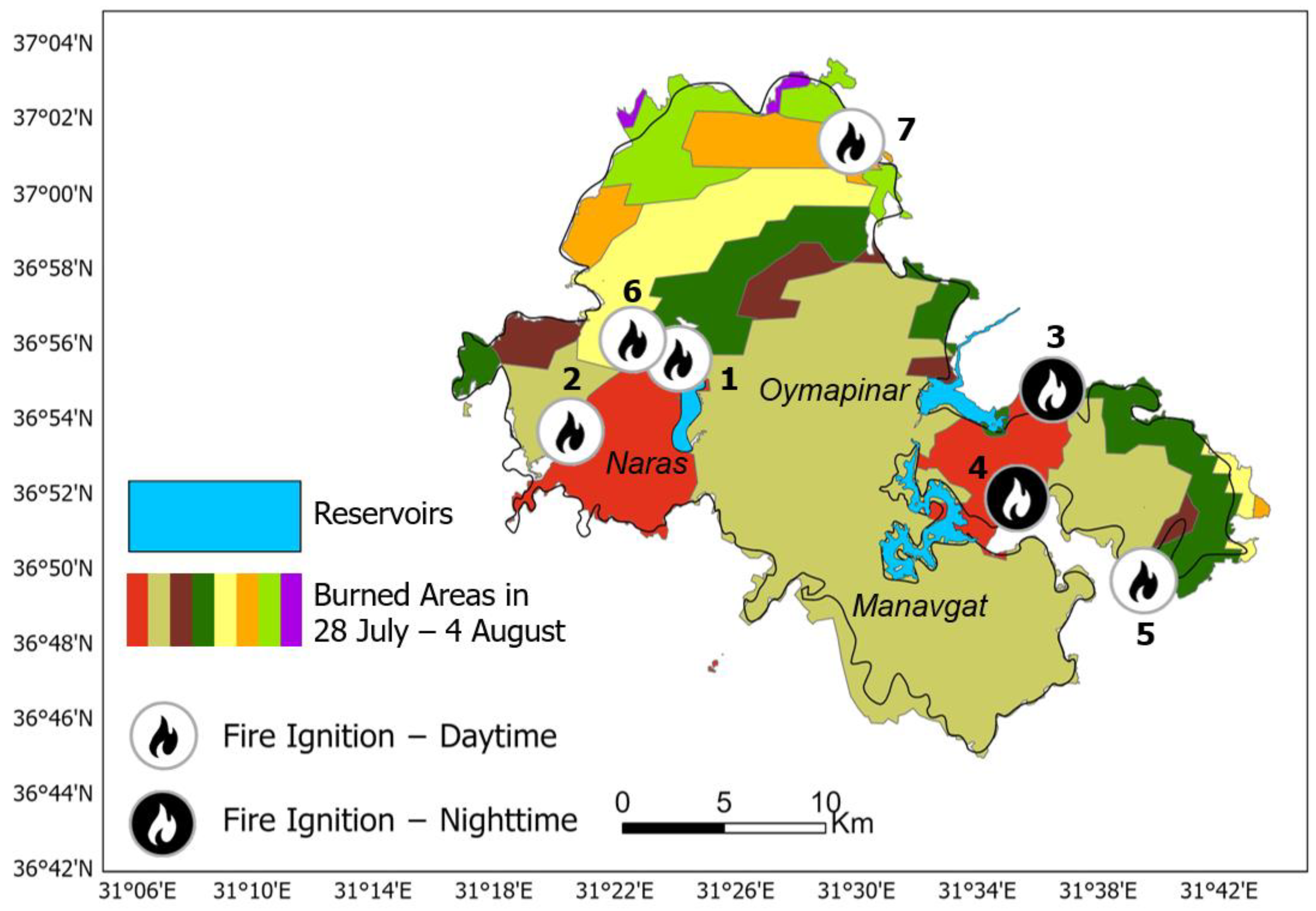
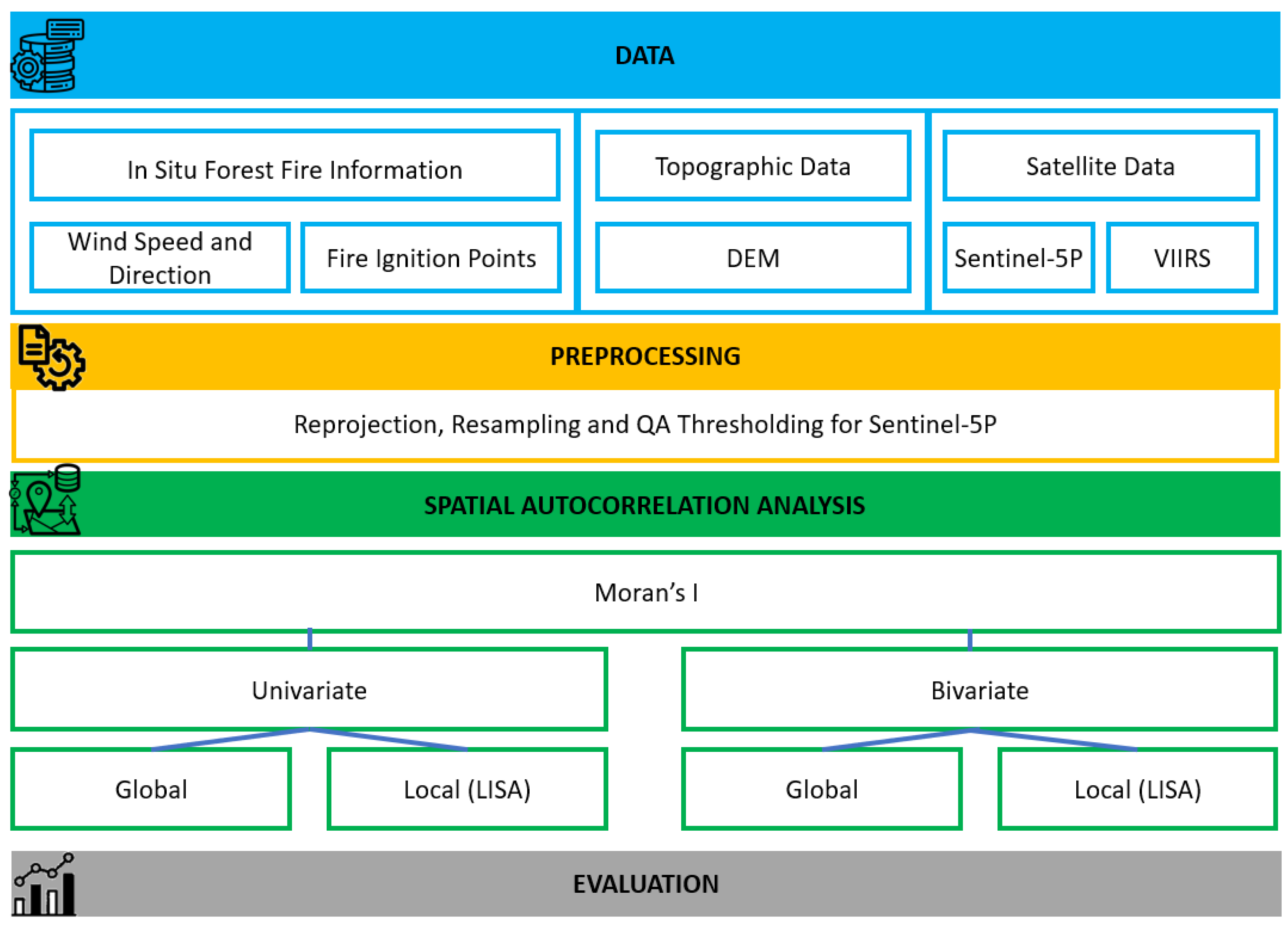
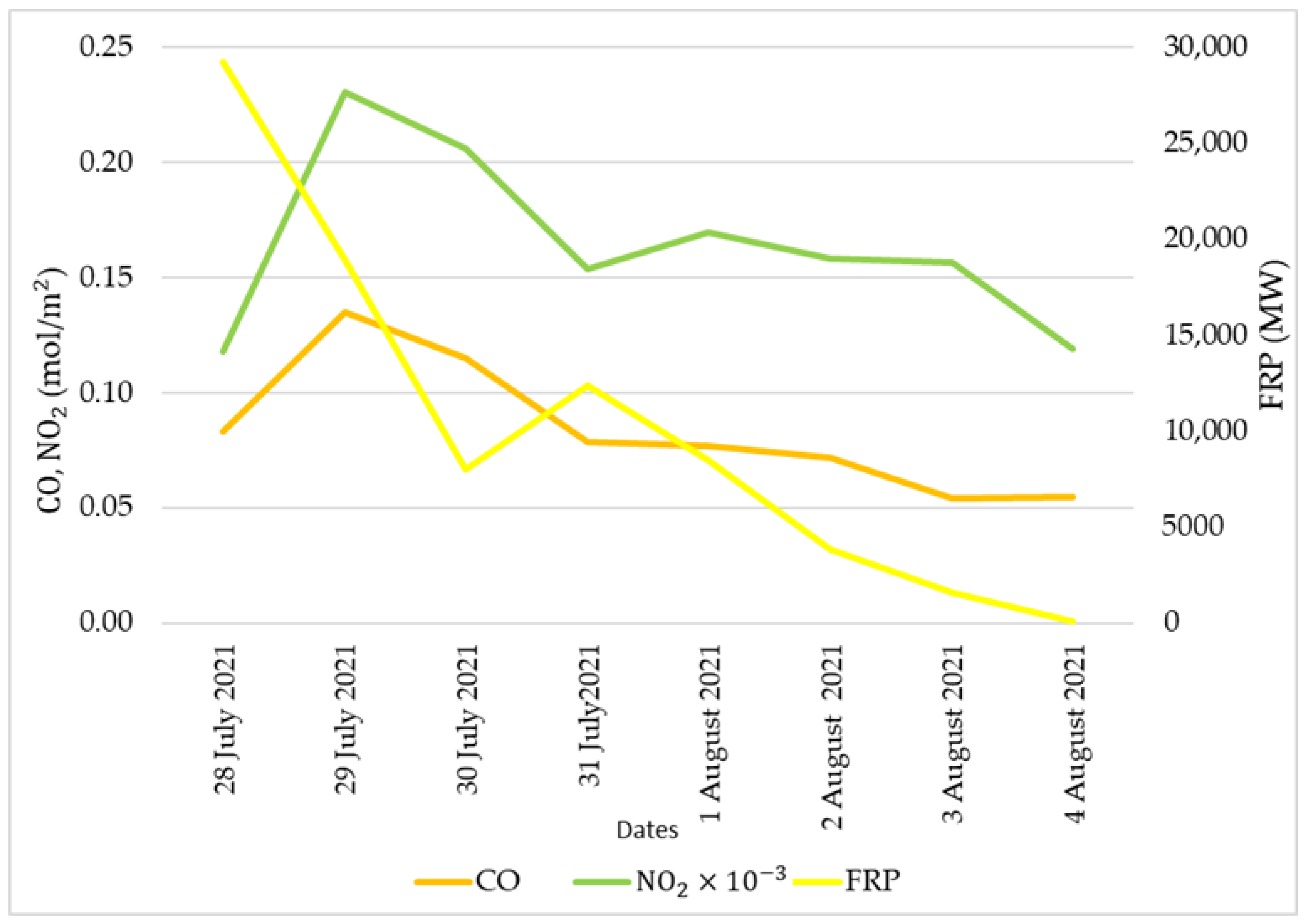
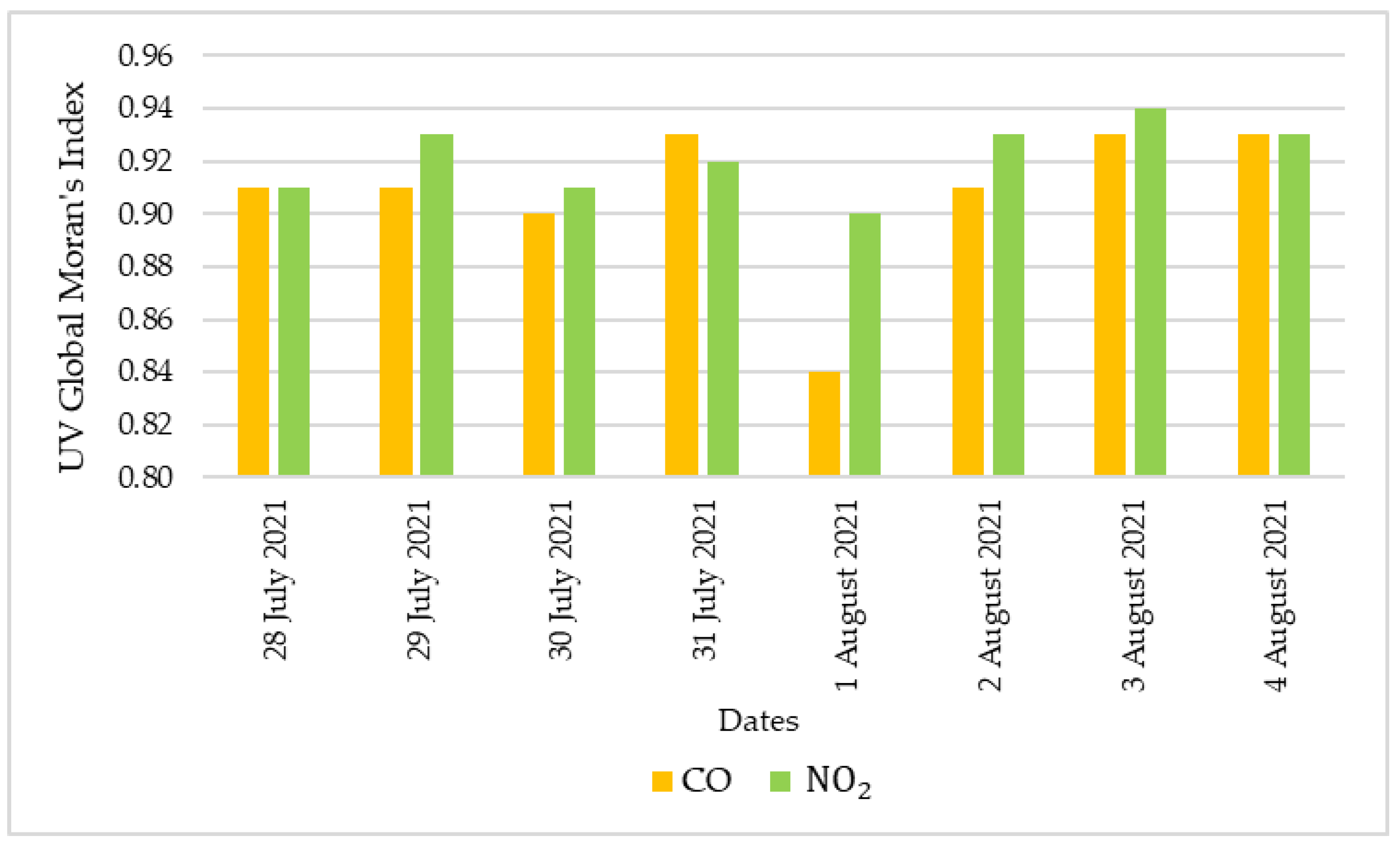
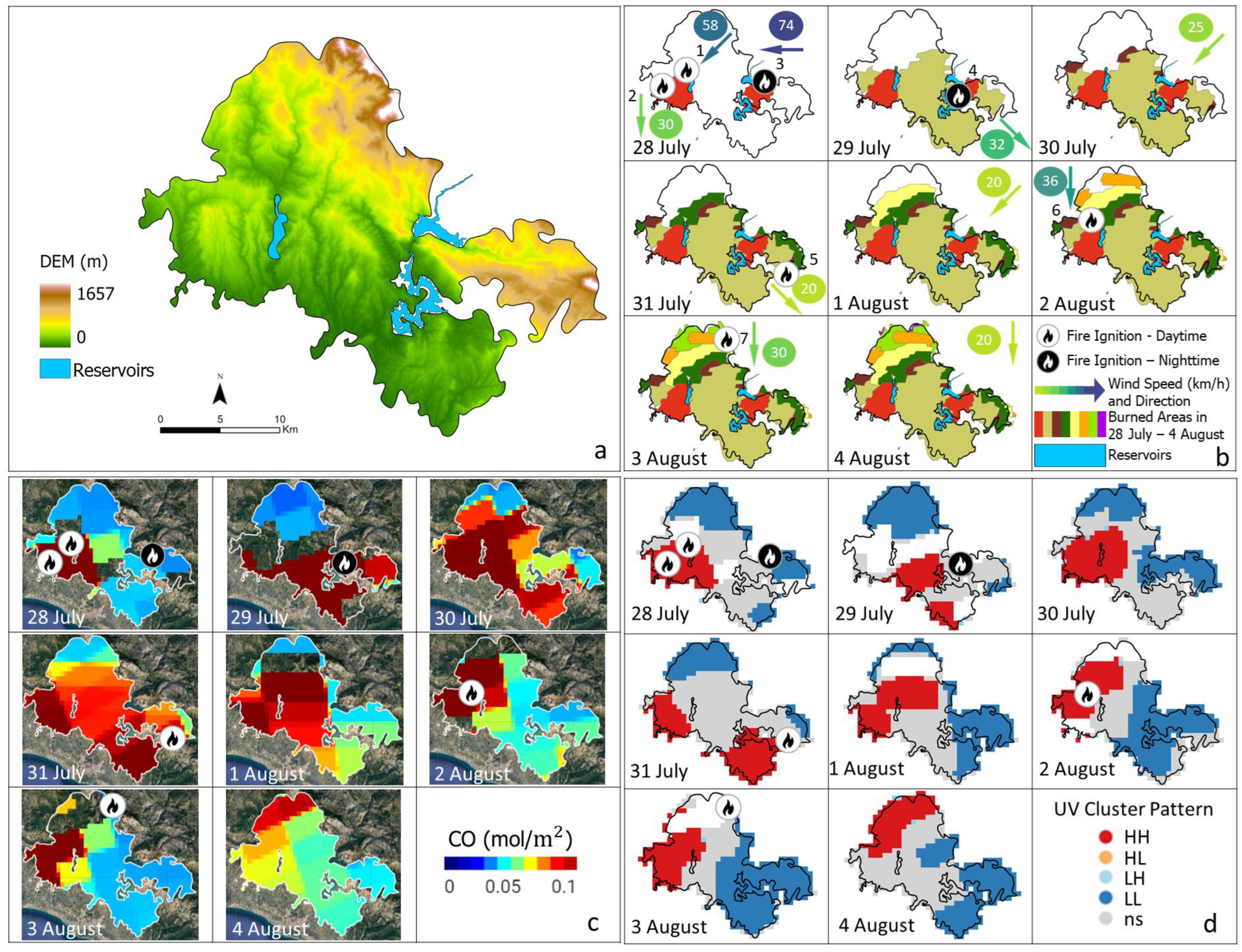

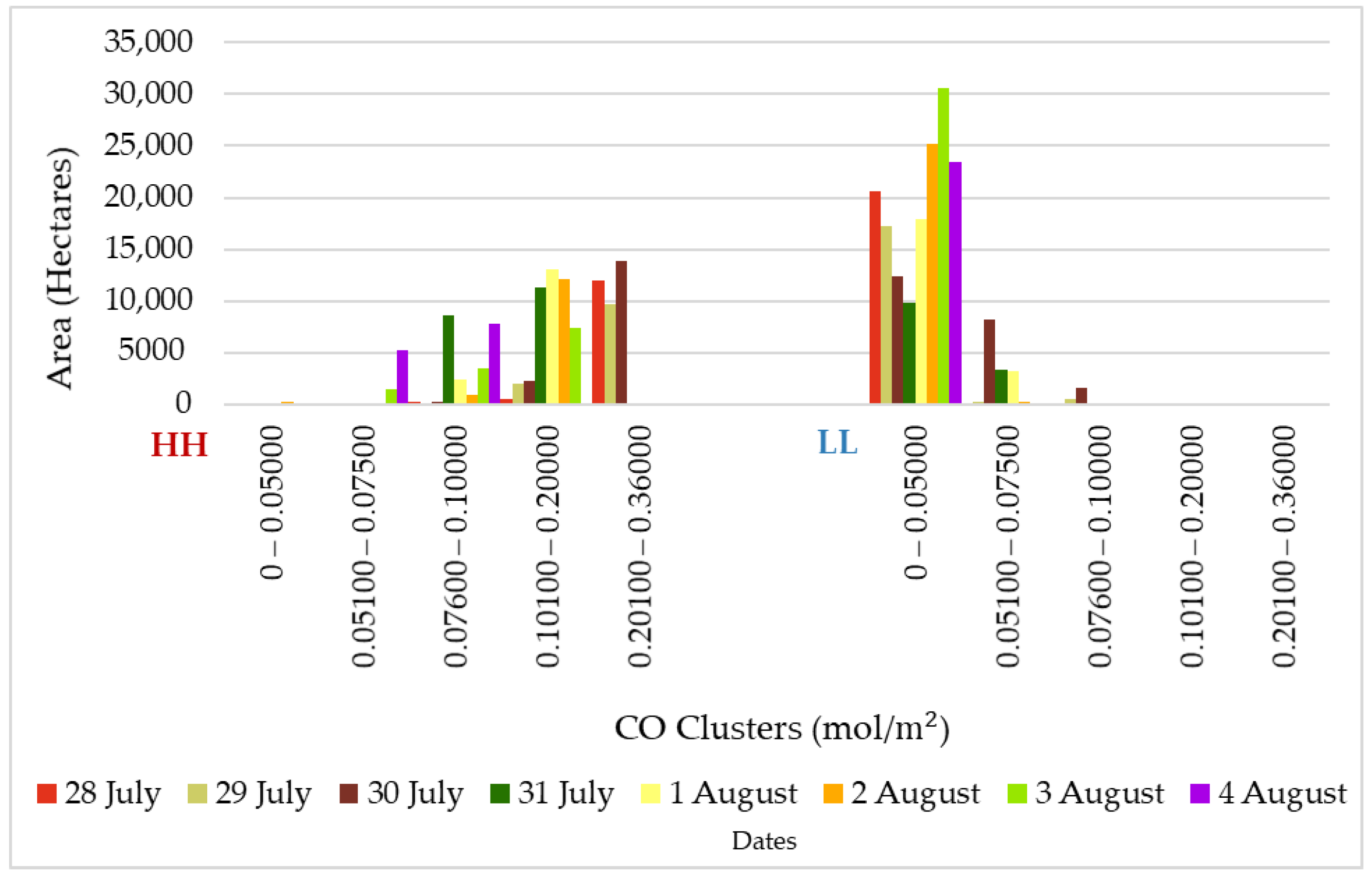

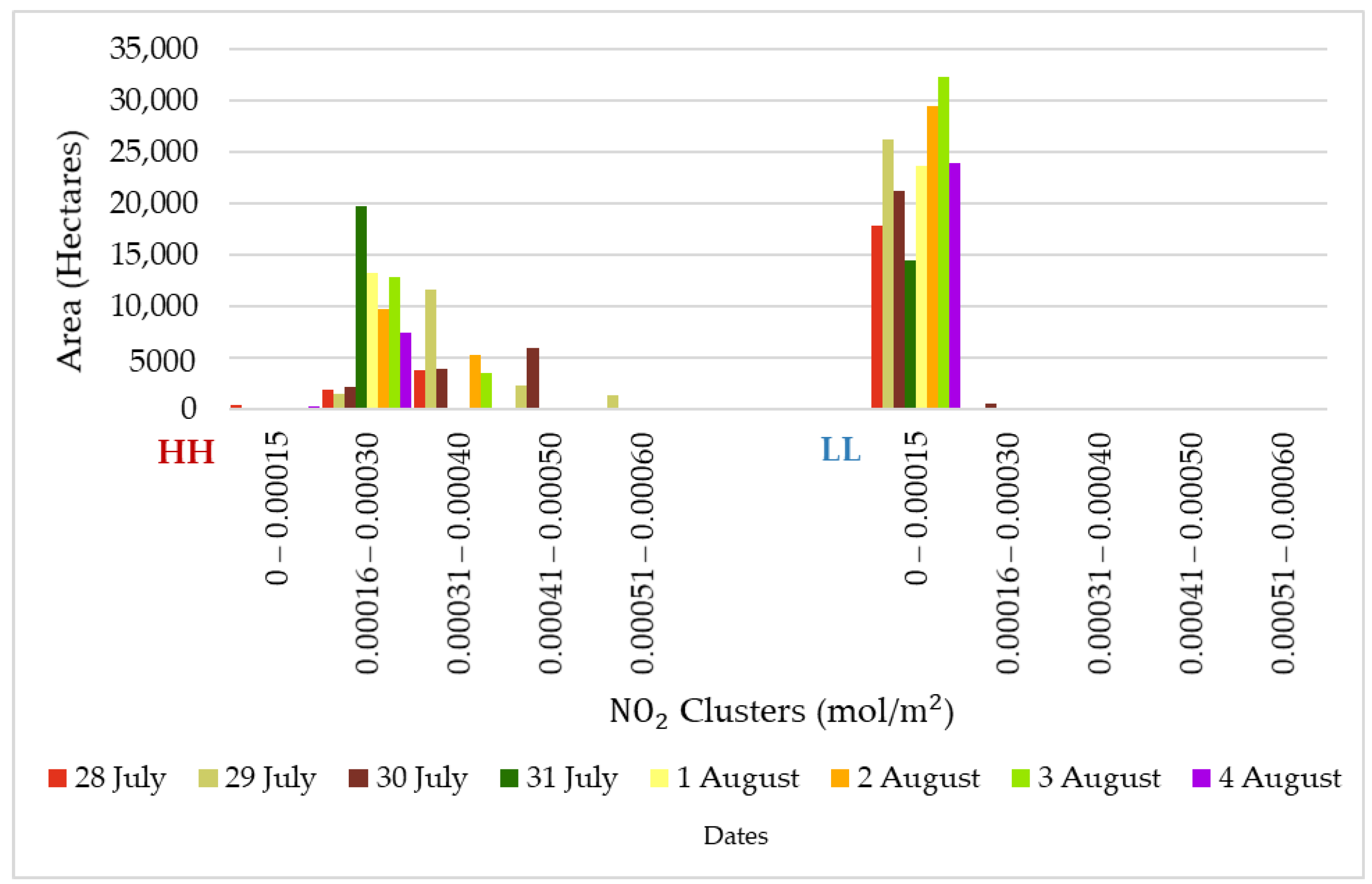
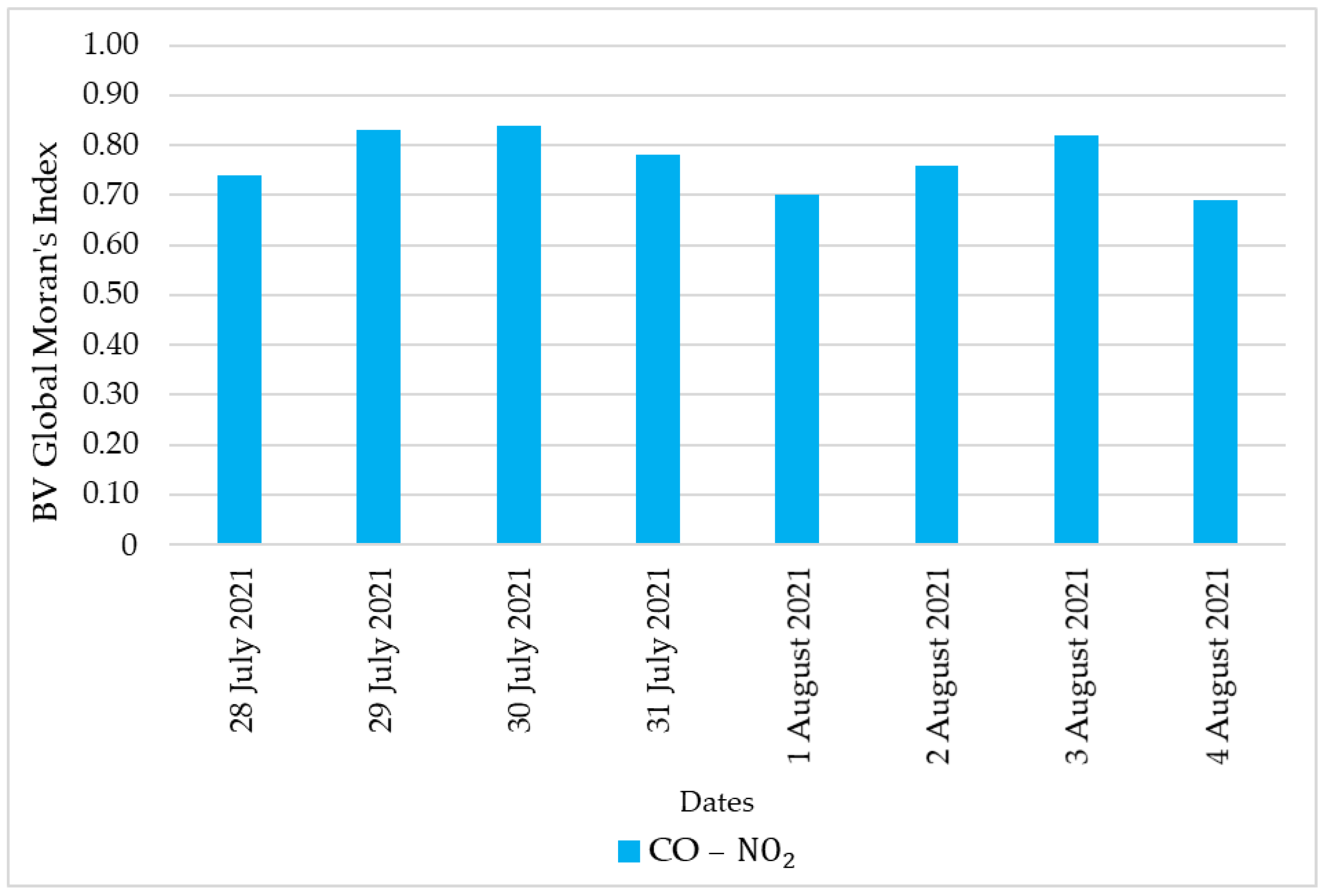
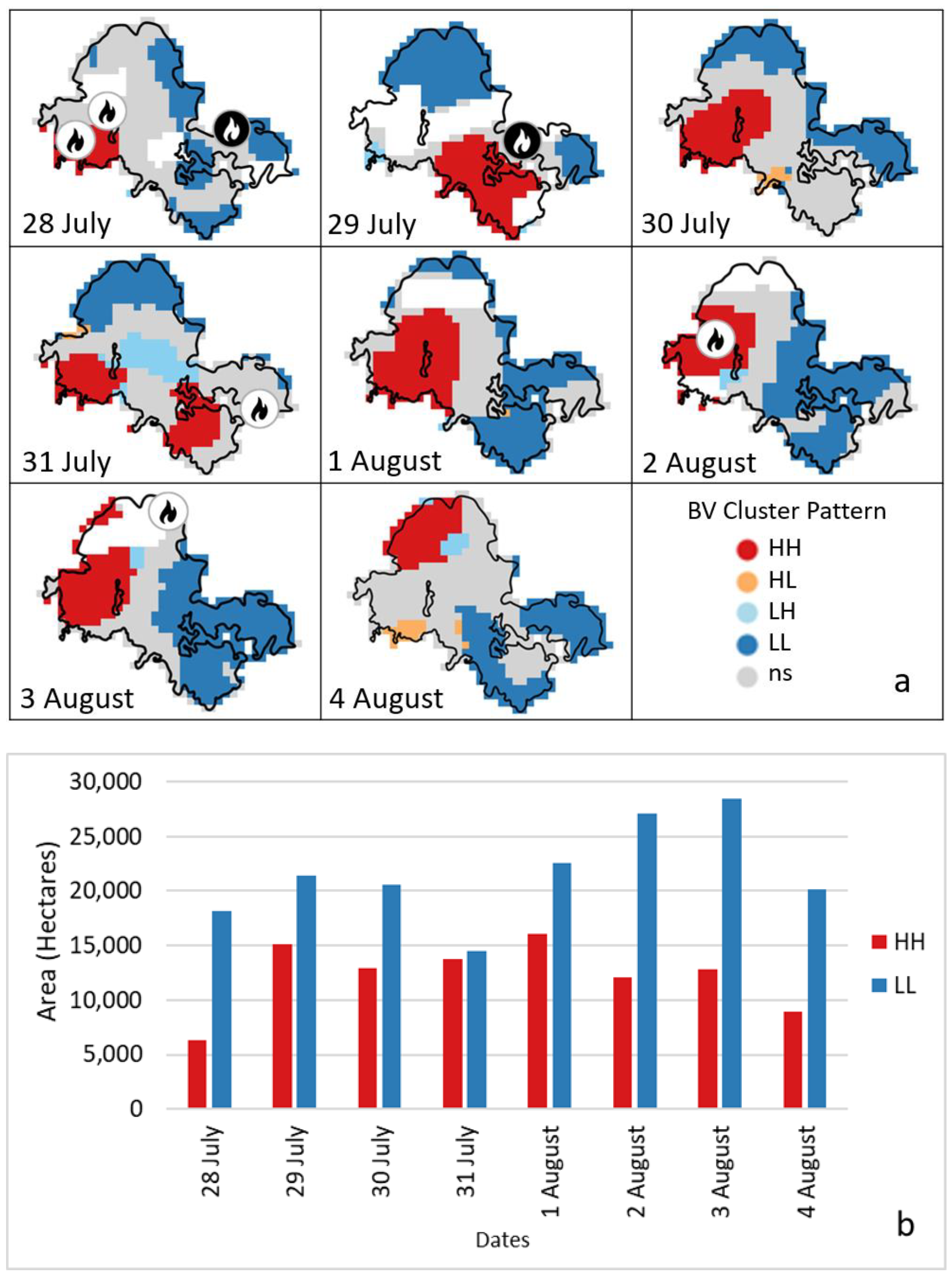

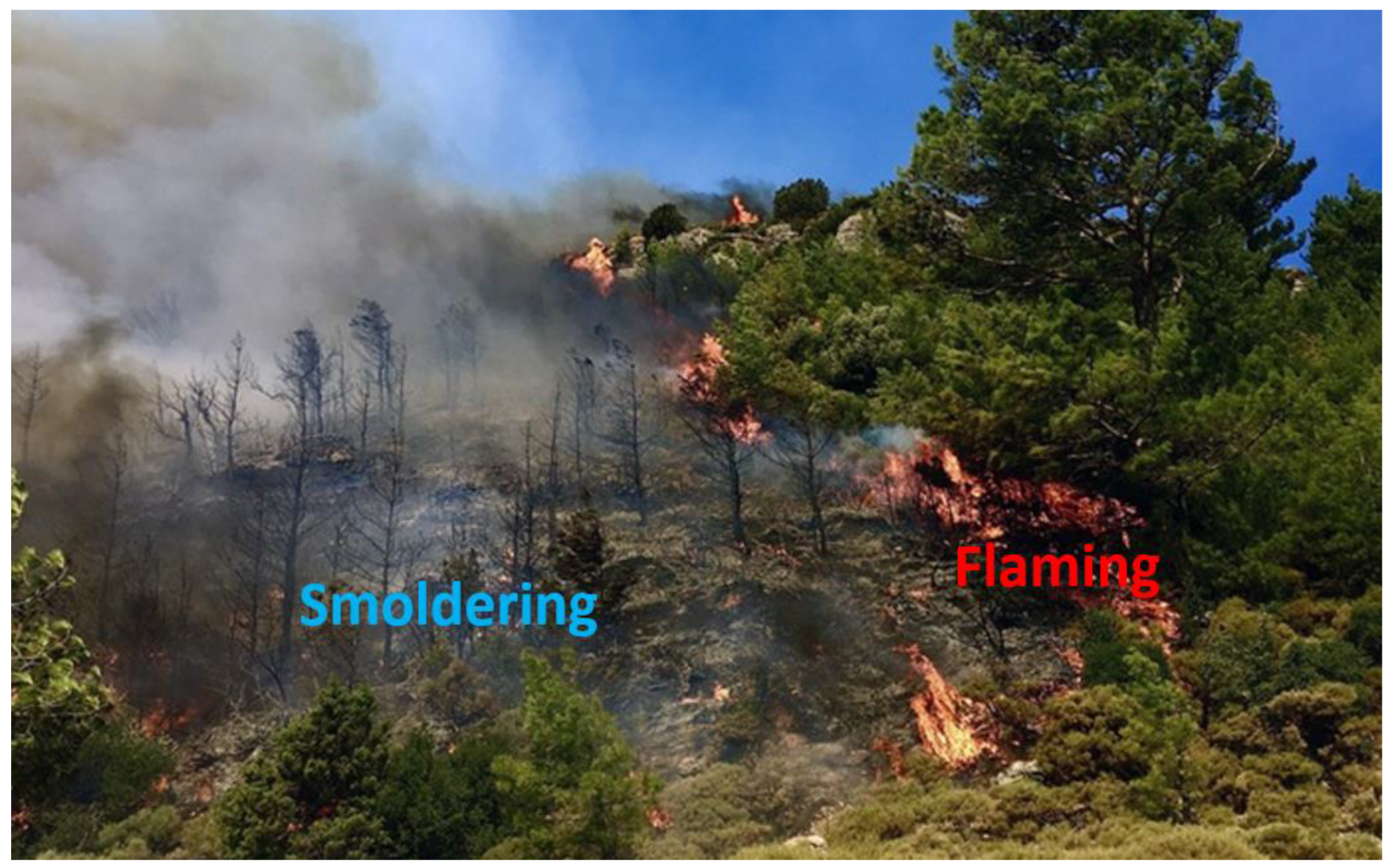
| Fire Start | First Response | Controlled | Extinguished | ||||||||||
|---|---|---|---|---|---|---|---|---|---|---|---|---|---|
| # | Date | Local Time | Date | Local Time | Date | Local Time | Date | Local Time | Humidity (%) | Max Temperature (°C) | Wind speed (km/h) | Wind Direction | Tree Species |
| 1 | 28 July 2021 | 11:58 | 28 July 2021 | 12:08 | 30 July 2021 | 15:00 | 7 September 2021 | 09:30 | 13 | 42 | 58 | NE | Redpine |
| 2 | 28 July 2021 | 16:00 | 28 July 2021 | 16:10 | 7 August 2021 | 09:30 | 1 September 2021 | 16:00 | 10 | 38 | 30 | N | Redpine |
| 3 | 28 July 2021 | 23:45 | 29 July 2021 | 00:10 | 3 August 2021 | 12:00 | 1 September 2021 | 14:30 | 25 | 32 | 74 | E | Redpine |
| 4 | 29 July 2021 | 01:30 | 29 July 2021 | 02:00 | 6 August 2021 | 08:30 | 3 September 2021 | 10:30 | 11 | 42 | 32 | NW | Redpine |
| 5 | 31 July 2021 | 19:00 | 31 July 2021 | 19:03 | 3 August 2021 | 12:00 | 1 September 2021 | 14:30 | 15 | 35 | 20 | NW | Redpine |
| 6 | 2 August 2021 | 13:00 | 2 August 2021 | 13:15 | 7 August 2021 | 09:30 | 5 September 2021 | 13:00 | 10 | 41 | 36 | N | Redpine |
| 7 | 3 August 2021 | 07:30 | 3 August 2021 | 08:30 | 7 August 2021 | 09:30 | 13 September 2021 | 07:30 | 15 | 32 | 30 | N | Blackpine |
Disclaimer/Publisher’s Note: The statements, opinions and data contained in all publications are solely those of the individual author(s) and contributor(s) and not of MDPI and/or the editor(s). MDPI and/or the editor(s) disclaim responsibility for any injury to people or property resulting from any ideas, methods, instructions or products referred to in the content. |
© 2025 by the authors. Published by MDPI on behalf of the International Society for Photogrammetry and Remote Sensing. Licensee MDPI, Basel, Switzerland. This article is an open access article distributed under the terms and conditions of the Creative Commons Attribution (CC BY) license (https://creativecommons.org/licenses/by/4.0/).
Share and Cite
Atalay, H.; Sunar, A.F.; Dervisoglu, A. Spatial Autocorrelation Analysis of CO and NO2 Related to Forest Fire Dynamics. ISPRS Int. J. Geo-Inf. 2025, 14, 65. https://doi.org/10.3390/ijgi14020065
Atalay H, Sunar AF, Dervisoglu A. Spatial Autocorrelation Analysis of CO and NO2 Related to Forest Fire Dynamics. ISPRS International Journal of Geo-Information. 2025; 14(2):65. https://doi.org/10.3390/ijgi14020065
Chicago/Turabian StyleAtalay, Hatice, Ayse Filiz Sunar, and Adalet Dervisoglu. 2025. "Spatial Autocorrelation Analysis of CO and NO2 Related to Forest Fire Dynamics" ISPRS International Journal of Geo-Information 14, no. 2: 65. https://doi.org/10.3390/ijgi14020065
APA StyleAtalay, H., Sunar, A. F., & Dervisoglu, A. (2025). Spatial Autocorrelation Analysis of CO and NO2 Related to Forest Fire Dynamics. ISPRS International Journal of Geo-Information, 14(2), 65. https://doi.org/10.3390/ijgi14020065







